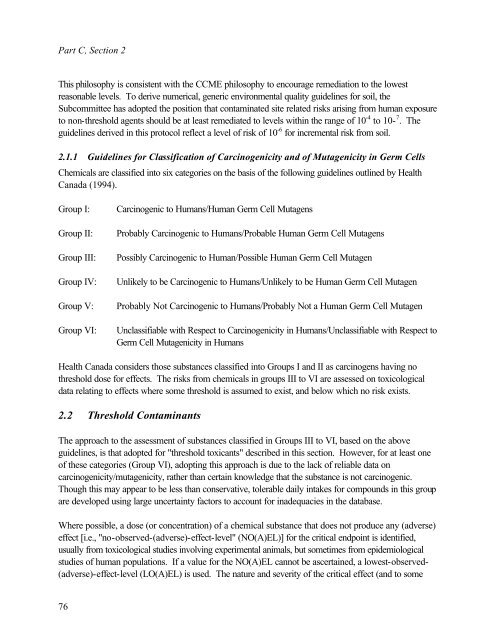Protocol for the Derivation of Environmental and Human ... - CCME
Protocol for the Derivation of Environmental and Human ... - CCME
Protocol for the Derivation of Environmental and Human ... - CCME
You also want an ePaper? Increase the reach of your titles
YUMPU automatically turns print PDFs into web optimized ePapers that Google loves.
Part C, Section 2<br />
This philosophy is consistent with <strong>the</strong> <strong>CCME</strong> philosophy to encourage remediation to <strong>the</strong> lowest<br />
reasonable levels. To derive numerical, generic environmental quality guidelines <strong>for</strong> soil, <strong>the</strong><br />
Subcommittee has adopted <strong>the</strong> position that contaminated site related risks arising from human exposure<br />
to non-threshold agents should be at least remediated to levels within <strong>the</strong> range <strong>of</strong> 10 -4 to 10- 7 . The<br />
guidelines derived in this protocol reflect a level <strong>of</strong> risk <strong>of</strong> 10 -6 <strong>for</strong> incremental risk from soil.<br />
2.1.1 Guidelines <strong>for</strong> Classification <strong>of</strong> Carcinogenicity <strong>and</strong> <strong>of</strong> Mutagenicity in Germ Cells<br />
Chemicals are classified into six categories on <strong>the</strong> basis <strong>of</strong> <strong>the</strong> following guidelines outlined by Health<br />
Canada (1994).<br />
Group I:<br />
Group II:<br />
Group III:<br />
Group IV:<br />
Group V:<br />
Group VI:<br />
Carcinogenic to <strong>Human</strong>s/<strong>Human</strong> Germ Cell Mutagens<br />
Probably Carcinogenic to <strong>Human</strong>s/Probable <strong>Human</strong> Germ Cell Mutagens<br />
Possibly Carcinogenic to <strong>Human</strong>/Possible <strong>Human</strong> Germ Cell Mutagen<br />
Unlikely to be Carcinogenic to <strong>Human</strong>s/Unlikely to be <strong>Human</strong> Germ Cell Mutagen<br />
Probably Not Carcinogenic to <strong>Human</strong>s/Probably Not a <strong>Human</strong> Germ Cell Mutagen<br />
Unclassifiable with Respect to Carcinogenicity in <strong>Human</strong>s/Unclassifiable with Respect to<br />
Germ Cell Mutagenicity in <strong>Human</strong>s<br />
Health Canada considers those substances classified into Groups I <strong>and</strong> II as carcinogens having no<br />
threshold dose <strong>for</strong> effects. The risks from chemicals in groups III to VI are assessed on toxicological<br />
data relating to effects where some threshold is assumed to exist, <strong>and</strong> below which no risk exists.<br />
2.2 Threshold Contaminants<br />
The approach to <strong>the</strong> assessment <strong>of</strong> substances classified in Groups III to VI, based on <strong>the</strong> above<br />
guidelines, is that adopted <strong>for</strong> "threshold toxicants" described in this section. However, <strong>for</strong> at least one<br />
<strong>of</strong> <strong>the</strong>se categories (Group VI), adopting this approach is due to <strong>the</strong> lack <strong>of</strong> reliable data on<br />
carcinogenicity/mutagenicity, ra<strong>the</strong>r than certain knowledge that <strong>the</strong> substance is not carcinogenic.<br />
Though this may appear to be less than conservative, tolerable daily intakes <strong>for</strong> compounds in this group<br />
are developed using large uncertainty factors to account <strong>for</strong> inadequacies in <strong>the</strong> database.<br />
Where possible, a dose (or concentration) <strong>of</strong> a chemical substance that does not produce any (adverse)<br />
effect [i.e., "no-observed-(adverse)-effect-level" (NO(A)EL)] <strong>for</strong> <strong>the</strong> critical endpoint is identified,<br />
usually from toxicological studies involving experimental animals, but sometimes from epidemiological<br />
studies <strong>of</strong> human populations. If a value <strong>for</strong> <strong>the</strong> NO(A)EL cannot be ascertained, a lowest-observed-<br />
(adverse)-effect-level (LO(A)EL) is used. The nature <strong>and</strong> severity <strong>of</strong> <strong>the</strong> critical effect (<strong>and</strong> to some<br />
76
















